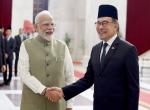There are certain stark realities of India which must form the background against which this paper is written. The first is that in the year 2010-11 as against a GDP growth rate of about 8 percent the growth of employment was 0.3 percent, that is, less than one-third of one percent. GDP growth showed a very healthy rate of increase, but this did not lead to an equivalent rate of growth of employment. Where has the extra money gone? It has not gone into investment which could lead to growth of employment and, therefore, one must assume that the extra money has gone into individuals’ pockets.
The second stark reality is that 46 percent of India’s children are suffering from malnutrition. This is perhaps an understatement based on what government itself admits, but certainly if half the children of the country are undernourished then the country must hang its head in shame. When we add to this our high infant mortality rate, which is only partially attributable to disease and is very much a function of the health of the mother, the nutrition available to the child and the level of affordability of the family, we have a situation in which we are breeding whole generations of people who are physically weak because of malnutrition. How can any country accept such a situation? There is a third, equally stark factor, which is that even today more than 85 percent of all employment is in the informal, unorganised sector. If from the total labour force we deduct this figure and add another 5 to 6 percent for unemployment, we would find that the organised sector is employing only between 8 and 10 percent of the entire work force. Much of the growth is in the organised sector, which means that productivity per capita of the work force is much higher than that of work in the unorganised sector. One straightaway opens a chasm between the organised sector which is relatively prosperous and the unorganised sector, where there is poverty and economic stagnation. We have created two economic worlds in the country, a tiny part of which is prosperous and the major part of which lives in penury.
How should we be governed and how should our economy be organised? The answers are given in the Constitution of India, the Preamble of which states that this Republic will secure to all its citizens Justice, social, economic and political and Equality of status and opportunity. This is not a pious statement of intention but it reflects the will of the people about the nature of the Republic which they have created. The Constitution goes further. Under Article 14 there is equality before law, which automatically cuts out most favoured treatment to anyone in the matter of law. Article 38 calls upon the State to secure a social order for the promotion of welfare of the people. The Article 38(1) reads: “The State shall strive to promote the welfare of the people by securing and protecting as effectively as it may a social order in which justice, social, economic and political, shall inform all the institutions of the national life. (2) The State shall in particular, strive to minimise the inequalities in income and endeavour to eliminate inequalities in status, facilities and opportunities, not only amongst individuals but also amongst groups of people residing in different areas or engaged in different vocations”. Article 39 prescribes that there are certain principles of policy which must be followed by the State. To quote, “The State shall, in particular, direct its policy towards securing – (b) that the ownership and control of the material resources of the community are so distributed as best to subserve the common good, (c) that the operation of the economic system does not result in the concentration of wealth and means of production to the common detriment”. Articles 14, 38 and 39, as also the Preamble of the Constitution, without going into the dialectics of socialism or communism, still make equity the pivot around which our economic system must revolve. Growth with equity, therefore, is not a matter of economics and charity and philanthropy alone – it is mandated by the Constitution and, therefore, no policy of government which ignores equity can be acceptable in India.
The planned economy which Nehru initiated did not come out of any ideological commitment to the Soviet model of total State control. In 1947 only about five thousand towns and villages of a total of two thousand five hundred towns and five and a half lakh villages were electrified. The capital goods industry consisted of a solitary steel plant run by the Tata Group at Jamshedpur. The road infrastructure was rudimentary and mainly dominated by the highways which had been constructed for military purposes. We did not manufacture motorcars, aircraft, tanks, warships or merchant ships; we had no Indian Institutes of Technology or Indian Institutes of Management and certainly no All India Institute of Medical Science. The British did not restrict investment of private capital, but those who had any money preferred to invest in trading rather than manufacture. A strong, modern State cannot be built on the foundations of a poor and nonexistent infrastructure and a rudimentary social infrastructure. It is only the State which had the capacity for both capital formation and capital investment at the time of Independence and it is this which brought the State into the economic scenario as the lead player which occupied the commanding heights of the economy. It is this decision of Nehru which gave us our huge dams and irrigation systems, steel plants, our power projects, our defence industry, our capital goods industry and a whole stream of downstream industry which converted the products of capital goods industries into items of daily use. It is Nehruvian planning and socialism which gave us great hospitals and institutions of higher learning and in fact created the basic foundations of a modern State. The role of the public sector was virtually that of the creator of modern India, which gave India an environment in which the private sector could begin to operate and ultimately strike out on its own. In creation of jobs, in building of infrastructure the public sector functioned with equity and regional balance in mind and certainly it promoted the just social order mandated by the Constitution. So far as the private sector is concerned, social justice is not its primary objective. The guiding factor for the private sector is profit and this is but natural.
The public sector came under immense criticism because somewhere down the line it lost it goal of creating wealth for the nation, building national infrastructure and promoting economic and social justice. Instead the public sector came under increasing political pressure to function as a handmaiden of politicians and bureaucrats, as a means of providing jobs; nepotism ruled the roost and siphoning off public funds for personal profit became common. This made the public sector highly inefficient and it became a burden on the State. Instead of reviewing performance and taking necessary steps to bring the public sector back on the rails, the neo liberalism of Rajiv Gandhi and Narsimha Rao, with Manmohan Singh acting as the main agent, denigrated and downgraded the public sector and promoted private enterprise as the future saviour of India. In such a scenario it is but natural that equity, social justice and national prosperity aimed at welfare of the people became a casualty, whereas wealth creation for individuals and corporate houses became the ruling mantra. China, the only major surviving communist country in the world, also chose the capitalist path to development, but in certain matters of equity and social justice China stood firm. Children do not starve in China and the majority of children go to school. Everyone in China has access at least to primary health care. The State has not given up its responsibility for ensuring at least minimum housing for its citizens. Making money is now not only legitimate but is encouraged in China, but destitution is not permitted to happen because the State steps in through social welfare. In India making money is legitimate, but social welfare is virtually nonexistent. Therefore, we have the phenomenon of a growth rate in excess of eight percent per annum coupled with half our children being malnourished. Grain is allowed to rot but we will not release it to the poor so that they can eat, if necessary free of cost.
There are certain sectors in which the State is a key player even in countries which are economically developed and which no longer adhere even to Fabian socialism. Education, health care and basic physical infrastructure continue to be the responsibility of State. That is why the initiative taken by the Eisenhower Administration to build forty thousand miles of Inter State Highways kick-started the American economy after the rigours of the Second World War. In the United States about ninety-five percent of all school education is state-funded, about half by the federal government and the balance evenly divided between the state governments and local government. Agriculture is regulated though a system of subsidies and taxes which encourage or discourage the cultivation of designated crops so that agriculture remains market friendly and the market itself gives adequate remuneration to the cultivators. Almost every form of commercial activity is overseen by regulatory authorities which protect the consumer. The so-called free market economy of the United States is regulated adequately to ensure some sort of level playing field for both industry and ordinary citizen and this is one face of equity. And let us remember that when the need arises government can be interventionist even in the United States. The ‘New Deal’ of President Roosevelt in the thirties of the last century was a huge programme of public spending for public works to counter unemployment during the Great Depression. When the economies melt down took place in the first decade of the twenty-first century President Obama virtually nationalised the banking system in order to prevent it from collapsing. The conservatism of the Republicans notwithstanding, the United States has responded to economic emergencies with direct and meaningful State intervention. Therefore, one must conclude that even in a capitalist economy equity is not lost sight of.
Let us take the case of India. It is shameful that the State is withdrawing rapidly from the field of education and health care. Government hospitals are being allowed to run into the ground through neglect, inadequate funding and non-recruitment of doctors. Private hospitals which charge high fess are allowed to, in fact encouraged to, flourish. Because we do not have a system of universal health insurance these facilities are accessible only to the rich. With government hospitals on the decline we are denying quality health care to the poor and this runs contrary to every principle of social justice.
The education scenario is no better. PPP -- Public Private Participation is the mantra of Montek Singh Ahluwalia which has been extended to school education also. I had proposed to the Prime Minister that we should set up at least ten thousand new Navodaya Schools. After three years of examination it was decided to set up six thousand such schools. The Planning Commission, so help us Lord, sat in judgement on the Prime Minister on and decreed that even this would be done in the PPP mode. Ultimately all that could be rescued was that three thousand five hundred schools would be set up by the State. Whether these ever see the light of day will depend upon how many more obstructions the Planning Commission raises. Who suffers? It is the deprived children of rural areas to whom the Navodaya Schools have given a glimpse of a world achievable by them, because if the schools are not set up they will be condemned for ever to the poor quality education provided by State schools. These children will never be able to compete with those whose parents can afford to educate them in elite schools and, therefore, the equity gap will widen. Despite the fact that certain demographers and our dear Planning Commission urge us to believe that India is fast urbanising, this is simply not true. Seventy-two percent of the population is still rural and if we take into account the people of small town India who live in semi rural conditions, this figure will go up to more than eighty percent. About half the urban population lives in metropolitan cities, but the other half lives in towns which are urban but have strong rural connectivity. We have deliberately and, in my opinion, very correctly, launched an ambitious rural employment guarantee programme aimed at providing employment in the rural sector and reducing migration to urban areas. This is a programme aimed at equity, but the way it is being operated it seems to be aimed at promoting corruption. The programme should have been one of creating rural assets which would improve the performance of the rural economy on a permanent basis. The manner in which Gujarat has separated the agricultural power feeder from the normal feeder and extended both to every village has resulted in a great deal of small industry migrating to rural Gujarat, thus upgrading the rural economy. This is growth with equity.
If we want equitable growth in which there is social justice and equality of opportunity for all we need more effective and efficient government intervention and not less. In infrastructure development, whether it is physical or social, the State has to be the primary player, especially in the field of education and health care. Evacuating these areas and handing them over to the private sector is tantamount to killing education for the poor and health care for the needy. The State has to ensure that the employment programmes are aimed at increasing the income of the poor, and there is greater affordability of grain and food stuffs so that the family itself can take care of nourishment. The job of the State is to ensure that essential commodities are uniformly available at affordable prices and for this purpose the State should not be afraid of giving a subsidy either directly to the consumer or indirectly through subsidising the producer and retailer so that the prices can be kept under control. Within this broad frame work private sector should be allowed to operate, with proper regulation but almost zero intervention. Wealth creation would naturally occur and, over time, would generate enough employment for the State to gradually withdraw from many sectors of economic activity. A credible, permanent institutional arrangement must be made by which the role of the State and the private sector is constantly reviewed and correctives applied where necessary.
Sitaram Yechury has been writing very sensible articles on the subject of growth with equity. Why did he not advise his own party’s government when it proposed the senseless acquisition of land in Nandigram? In fact Narendra Modi’s policy of not acquiring fertile land for industry is much more socially correct than that of the Left Front government in West Bengal, which thought that it could emulate China, which displaced thirty lakh people for construction of the Three Gorges Dam whilst ruthlessly suppressing any public protest. The policies of the Left Front in both Wet Bengal and Kerala discouraged growth while simultaneously failing to promote social justice and equity. Our growth model has to promote growth, but with social justice and equity. The definition of a level playing field under these circumstances is that there will be no monopoly in any sector, there will be healthy competition with minimum State intervention, but that the State will ensure through regulation, through policy directives and, where necessary, by direct intervention that growth and prosperity are equally shared by all. This means that if Mukesh Ambani wants to spend several hundred crores on building a residence for himself in Mumbai, which he does not even occupy, he will either not be permitted to do so by order of government or he will have to pay a very heavy tax, which amount would be used for creating social infrastructure, including housing for the poor. If the Swaminarayan sect of Gujarat, undoubtedly one of the richest religious groups in the world, wants to spend Rupees three thousand five hundred crores on an Akshardham temple in London or Rupees one thousand five hundred crores on a temple in Delhi it will be allowed to spend only a tenth of this amount for the temples, whilst ninety percent of the amount will have to be invested for employment generation or in creation of social assets. In a country where there is a resource crunch the wretched Planning Commission should not be involved in promoting the PPP mode. Instead it should help to evolve a regulatory regime and a tax structure which encourages investment in infrastructure and job creation rather than in conspicuous consumption whose vulgarity can only be equalled by the oil rich Arab Sheikhs or by Asif Zardari of Pakistan.
Published Date : 15th February 2012









Post new comment